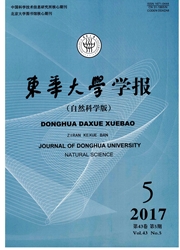

 中文摘要:
中文摘要:
采用次氯酸钾法制备高铁酸钾,并用于降解水中的苯胺.通过对比试验证明高铁酸钾对苯胺的去除效果远优于单用三氯化铁絮凝剂及次氯酸钾氧化剂,其最佳反应条件为:在高铁酸钾投量与苯胺的摩尔比为1∶1,pH值=3.0~9.0,反应时间为20min的条件下,苯胺的去除率可达80%以上.根据高铁酸钾降解苯胺的产物光谱分析可知,高铁酸根首先对苯环上的NH2发起攻击,通过一系列反应生成偶氮苯等中间产物,这些中间产物有一部分可被开环并继续被氧化成为烷烃及烯烃等脂肪烃,但反应后残余的偶氮苯等中间产物依然是微生物难降解物质.高铁酸钾应用于难降解苯胺废水生物处理的预处理,可以有效去除废水中苯胺,并在一定程度上改善苯胺废水的可生化性.
 英文摘要:
英文摘要:
Potassium ferrate was made by the potassium hypochlorite method and was used to degrade aniline in water. According to the comparative experiments,the potassium ferrate was more effective to degrade aniline than the flocculant ferric chloride and the oxidant potassium hypochlorite. The aniline removal ratio was more than 80% under the optimum reaction conditions for aniline degradation by potassium ferrate:the molar ratio of potassium ferrate to aniline 1:1,pH value 3.0-9.0 and reaction time 20 min. Based on the analysis of aniline degradation products,ferrate (Ⅵ) ion firstly attack at –NH2 on benzene,producing azobenzene and other compounds by series of reaction. Part of those compounds could be opened rings and oxidized to aliphatic hydrocarbon compounds,but the remained azobenzene is also recalcitrant for microorganisms to degrade. Potassium ferrate oxidation is an effective method to remove aniline from water to increase the aniline wastewater biodegradability.
 同期刊论文项目
同期刊论文项目
 同项目期刊论文
同项目期刊论文
 期刊信息
期刊信息
